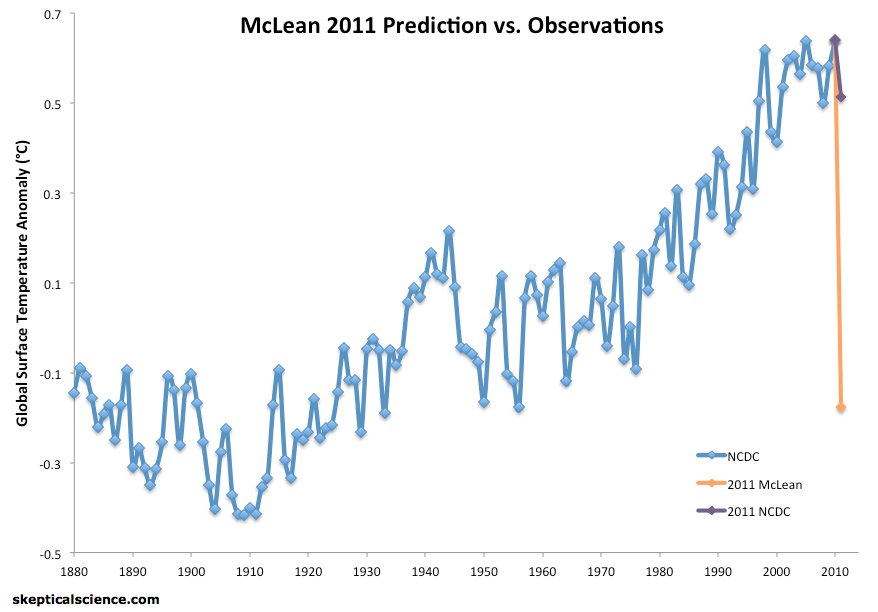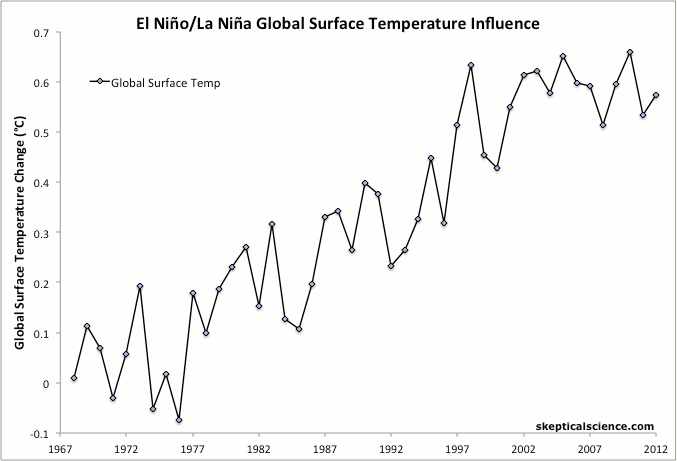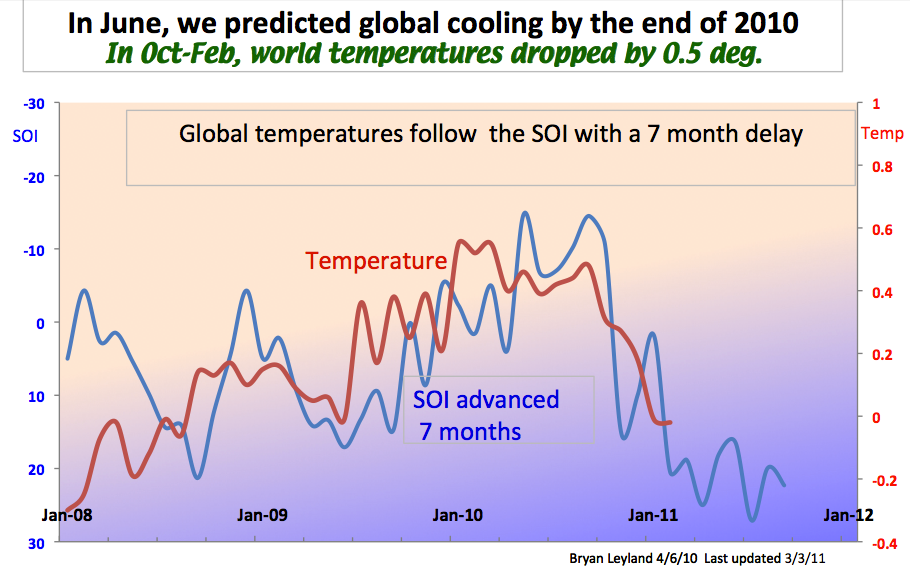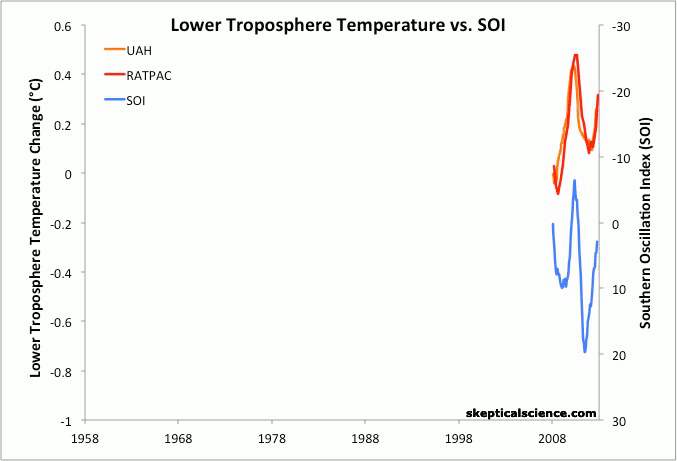Distinguishing Between Short-Term Variability and Long-Term Trends
Posted on 6 May 2013 by dana1981
We previously examined a paper published by McLean, de Freitas, and Carter (2009) which showed that most of the short-term variability in lower atmosphere temperatures is due to changes in the El Niño Southern Oscilliation (ENSO). This was not a new finding at the time, but the authors also subsequently claimed that changes in ENSO could explain a substantial amount of the long-term global warming trend. This claim was not supported by the analysis in their paper.
Nevertheless, lead author John McLean predicted a record-shattering cooling for the year 2011, based on the methodology in their paper. As we subsequently documented, that prediction was quite far off (Figure 1).
Figure 1: NCDC global average surface temperature from 1880 through 2010 (blue), McLean's 2011 prediction (orange), and the actual 2011 NCDC temperature (purple).
Average global surface temperatures were cooler in 2011 than 2010 mainly as a result of changes in ENSO. We know that La Niña years tend to be colder at the Earth's surface while El Niño years tend to be hotter (Figure 2).
Figure 2: NOAA annual global surface temperatures from 1968 through 2012 with La Niña years in blue, El Niño years in red, ENSO neutral years in black, and volcanic years as orange triangles. Linear trends for 1968–2012 for each of the three categories (excluding volcanic years) are shown in the final frame.
However, McLean predicted:
"It is likely that 2011 will be the coolest year since 1956"
For that to be true would have required overcoming about 0.75°C of global surface warming over the prior 55 years. In short, McLean mistook short-term variability with the long-term global warming trend.
We can also illustrate this difference graphically. A climate contrarian blog attempted to support McLean's failed prediction with the graphic shown as Figure 3.
Figure 3: Climate contrarian defense of McLean's 2011 prediction (source)
Again, this shows short-term temperature changes closely following ENSO (specifically the Southern Oscillation Index [SOI]). However, the graphic only shows a very short timeframe. How do SOI and lower atmosphere temperatures compare over the long-term?
We answer this question in Figure 4. This figure compares the same data sets used in McLean et al. (2009): the SOI (blue) compared to lower troposphere temperatures as measured by satellites (by the University of Alabama at Huntsville [UAH], orange) and radiosondes (instruments on weather balloons [RATPAC-A] from NOAA, red).
The first frame shows the same timeframe as in Figure 3, followed by the long-term data since 1958, the linear trends, and finally the de-trended data.
Figure 4: SOI (blue) compared to lower troposphere temperatures as measured by satellites (UAH, orange) and radiosondes (RATPAC-A, red), with 12-month running averages, as in McLean et al. (2013). The first frame shows the data since 2008, the second frame since 1958, the third frame adds the linear trends, and the fourth shows the de-trended data.
As Figure 4 illustrates, SOI has no long-term trend. After all, ENSO is an oscillation which alternates between El Niño and La Niña cycles. Over the long-term, these cycles average out to zero. Meanwhile the lower atmosphere has warmed substantially due to human-caused global warming.
If we remove the long-term warming trends, we can see once again that the short-term wiggles in the temperature data are strongly influenced by changes in ENSO. However, the long-term global warming trends are not – they are due to the human-caused increased greenhouse effect.































 Arguments
Arguments


































First paragraph below Fig 4. hyperlink 'McClean et al. (2013)' perhaps should be (2009)?
Funny how these failed predictions are seldom revisited by 'sceptic' blogs, isn't it.
cargo transportation Thank you for a very interesting post!
dwr @1 - yes thanks, typo corrected. Indeed I haven't seen any contrarian blogs revisit McLean's prediction, other than the one mentioned in this post that rather absurdly tried to argue he was right.
I know your philosophy is to tackle the science rather than the contexts that surround it, but a naive reader may get the impression from the beginning of the post that McLean is a legit climate researcher. His ridiculous prediction may say to a naive reader -- "I knew those climate science jerks didn't know anything about how climate works." But really that would be the wrong impression.
David Archibald makes a similar prediction (catastrophic temp drop) for 2013 based on solar activity. We can visit that next year!
So SOI has no trend, but temperature has.
But even if SOI had a trend, this would not disprove human induced global warming: SOI could potentially be altered or given a trend by human made global warming (or even be disrupted completely by the human caused temperature change): a correlation does not explain which factor is the physical cause ...
John Chapman @5 - do you have a link to that Archibald prediction?
Dana - I suspect John had http://wattsupwiththat.com/2012/08/13/when-will-it-start-cooling/ in mind, though it's nowhere near as dramatic a drop as McLean was foolish enough to predict and it looks to me as though Archibald left himself a fair bit of wiggle room to claim, at least for a few more years, that the failure of cooling to start when he said it was likely to doesn't invalidate his longer term prediction of major cooling over the course of the next few solar cycles.
Dana, now that I hunt it down I see the year is more like 2015 rather than 2013, though there would have to be a transition towards 2015. The source is www.skepticalscience.com/david-archibald-exaggerates-solar-influence-on-future-climate-c see figure 3.